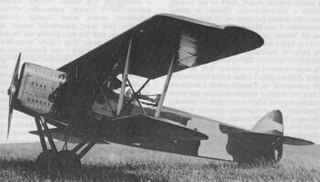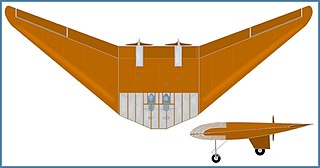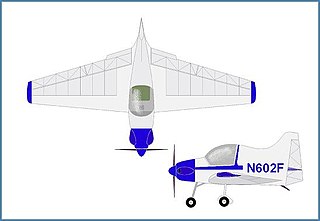Related Research Articles

The Horten H.IX, RLM designation Ho 229 was a German prototype fighter/bomber initially designed by Reimar and Walter Horten to be built by Gothaer Waggonfabrik late in World War II. It was the first flying wing to be powered by jet engines.

The Dornier Do 12 Libelle III was the third of a line of small German flying boats of the 1930s. It started with the Dornier A Libelle I and the Dornier A Libelle II, though the Do 12 was not a continuation, but an entirely new aircraft.

The Aero A.11 was a biplane light bomber and reconnaissance aircraft built in Czechoslovakia between the First and Second World Wars. It formed the basis for many other Czechoslovakian military aircraft of the inter-war period. Around 250 were built, with some remaining in service at the outbreak of World War II.

The Horten H.XVIII was a proposed German World War II intercontinental bomber, designed by the Horten brothers. The unbuilt H.XVIII represented, in many respects, a scaled-up version of the Horten Ho 229, a prototype jet fighter. The H.XVIII was one of many proposed designs for an Amerikabomber, and would have carried sufficient fuel for transatlantic flights. The XVIIIA variant, with its wood structure, buried engines in the fuselage, flying wing design and carbon-based glue component, would have been, in theory, the first stealth bomber in history.

The Sukhoi Su-31 is a Russian single-engined aerobatic aircraft designed by Sukhoi as a lighter and more powerful version of the Sukhoi Su-29.

The CZAW Mermaid is an amphibious flying boat light-sport aircraft produced by Czech Sport Aircraft in the Czech Republic.
The Keystone XO-15 was an American prototype observation aircraft, built by the Keystone Aircraft Corporation for the United States Army Air Corps, First flown in 1930, only a single prototype was built.

The Henschel Hs 125 was a German advanced training aircraft prototype featuring a single engine and low wing, designed by Henschel & Son and tested by the Luftwaffe in 1934. Only two prototypes were ever built.

The Comte AC-12 Moskito was a 1930s Swiss three-seat light touring cabin monoplane produced by Flugzeugbau A. Comte.

The Horten H.III was a flying wing sailplane built by Walter and Reimar Horten in Germany from 1937 to 1944.

The Heinkel He 71 was a German single-seat monoplane, a smaller version of the two-seat Heinkel He 64. A low-wing monoplane with a fixed conventional landing gear, the prototype first flew with an open cockpit and a 60 hp (45 kW) Hirth HM 60 engine. It was later modified with an enclosed cabin and a 78 hp (58 kW) Hirth HM 4 engine. With additional fuel tanks to increase range it was used by German aviator Elly Beinhorn on a flight around Africa.
The Supermarine Type 179 "Giant" was a British monoplane flying boat developed by Supermarine but cancelled before completion.
The Albatros L 103 / Albatros Al 103 was a German experimental aircraft of the 1930s. It was a parasol-wing landplane of conventional configuration, seating the pilot and flight test observer in separate, open cockpits. The Al 103 was used to test variations in sweepback, dihedral and tailplane area.
The BAaer Gurí is an Argentine ultralight aircraft, designed and produced by BAaer (BA-Aeroplanos) of Buenos Aires. When it was available the aircraft was supplied as a kit for amateur construction.
The Skyfly S-34 Skystar is a Swiss ultralight aircraft, designed by Hans Gygax and produced by Skyfly, of Altbüron. The aircraft is supplied as a kit for amateur construction or as a complete ready-to-fly-aircraft.

The Airdrome Fokker D-VIII is an American amateur-built aircraft, designed and produced by Airdrome Aeroplanes, of Holden, Missouri. The aircraft is supplied as a kit for amateur construction.
The Bagalini Baganfibio is an Italian homebuilt flying boat that was designed by Marino Bagalini. The aircraft is supplied in the form of plans for amateur construction.

The Horten H.V was a delta-winged, tail-less, twin-engined motor-glider designed and built in the late 1930s and early 1940s by Walter and Reimar Horten in Germany. The H.V aircraft were used for various experimental duties, including: innovative structure, performance, stability and control of flying wing aircraft. The first H.V was the first aircraft to be built using an all composite material structure.

The Fauvel AV.60 (AV for aile volante was a flying wing tourism aircraft built in France in the early 1960s. It was a low-wing monoplane of wooden construction, featuring a flying wing layout.

The Horten H.VII was a flying wing fighter-trainer aircraft designed by the Horten brothers in Nazi Germany during World War II.
References
Notes
Bibliography
- Lee, Russell E. (2020). Only the Wing. Smithsonian.